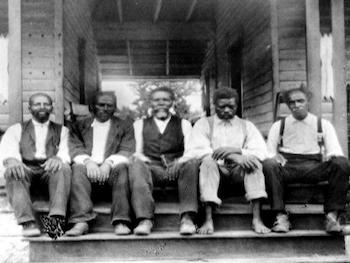Let it play in the background as you study and immerse yourself in this topic!
The Colored Farmers’ National Alliance and Cooperative Union was established by a small group of Black farmers on December 11, 1886, in Houston County, Texas. The Colored Alliance was established because the Southern Farmers’ Alliance barred Blacks from joining their organization due to their race. The Colored Farmers’ Alliance was also founded on the farm of R.M. Humphrey, a white Alliance member and Baptist missionary. The organization elected J.J. Shuffer as its president and H.S. Spencer as secretary. Humphrey was elected as general superintendent despite the organization barring whites from membership.
In 1888, the Colored Alliance received a charter from the US Federal Government. Humphrey began to organized chapters through out the Southern United States although they faced competition from a rival group, the National Colored Alliance, led by Andrew J. Carothers. In 1890, the two rival groups merged. The organization was also able to absorb the Colored Agricultural Wheels in Arkansas, western Tennessee, and Alabama. By 1890 the organization claimed around 1,200,000 members.
The Colored Farmer’s National Alliance helped it members to become better farmers. It established a weekly newspaper called the National Alliance and created exchanges in the ports of Charleston, Houston, Mobile, New Orleans, and Norfolk, which the members bought goods at reduced prices and obtained loans to pay off mortgages. They also raised funds to provide longer public-school terms and found, and in some places, it educational academies. The Colored Alliance also solicited funds to help sick and disabled members and advised its members on the most effective ways to combat racial prejudice if they owned their own homes and farms. They also urged Alliance members to avoid debt.
The Colored Alliance would occasionally cooperate with the Southern Alliance. The two organizations called for the abolition of the Louisiana lottery, which they feared would lead farmers into debt. The two organizations also opposed the Conger lard bill, which attempted to impose taxes upon the production of vegetable oil. The two organizations differed however on the Lodge election bill which promised federal protection to safeguard African American voting rights in the south. While the Colored Alliance supported the bill, the Southern Alliance condemned the bill. In September 1891, the Colored Alliance called for cotton pickers throughout the South to strike to support their demand for a wage increase from 50 cents to $1 per hundred pounds of cotton. The Southern Alliance opposed the strike.
The Colored Alliance leadership lacked the resources to mobilize across the South because most Black agricultural workers were illiterate sharecroppers who lacked alternative sources of income. To make matters worse, the Cotton pickers’ strike of 1891 occurred in Lee County, Arkansas where 50 strikers were killed including several who were lynched. The failed strike contributed to the demise of the Colored Farmers’ Alliance by the end of 1891.
Do you find this information helpful? A small donation would help us keep this available to all. Forego a bottle of soda and donate its cost to us for the information you just learned, and feel good about helping to make it available to everyone.
BlackPast.org is a 501(c)(3) non-profit and our EIN is 26-1625373. Your donation is fully tax-deductible.
“Colored Farmers’ National Alliance and Cooperative Union,” Texas State Historical Association,https://www.tshaonline.org/handbook/entries/colored-farmers-alliance;
“Colored Farmers’ National Alliance and Cooperative Union,” Cornell University Library,https://africana.library.cornell.edu/thesis/out-of-the-lions-mouth-the-colored-farmers-alliance-in-the-new-south-1886-1892/;
Omar H. Ali, “Black Populism in the New South, 1886-1898.” Ph.D. dissertation, Columbia University, 2003.
The Colored Farmers’ Alliance.https://youtu.be/DmmQaAuAmng?si=sQ3eVTTegEryjrct

